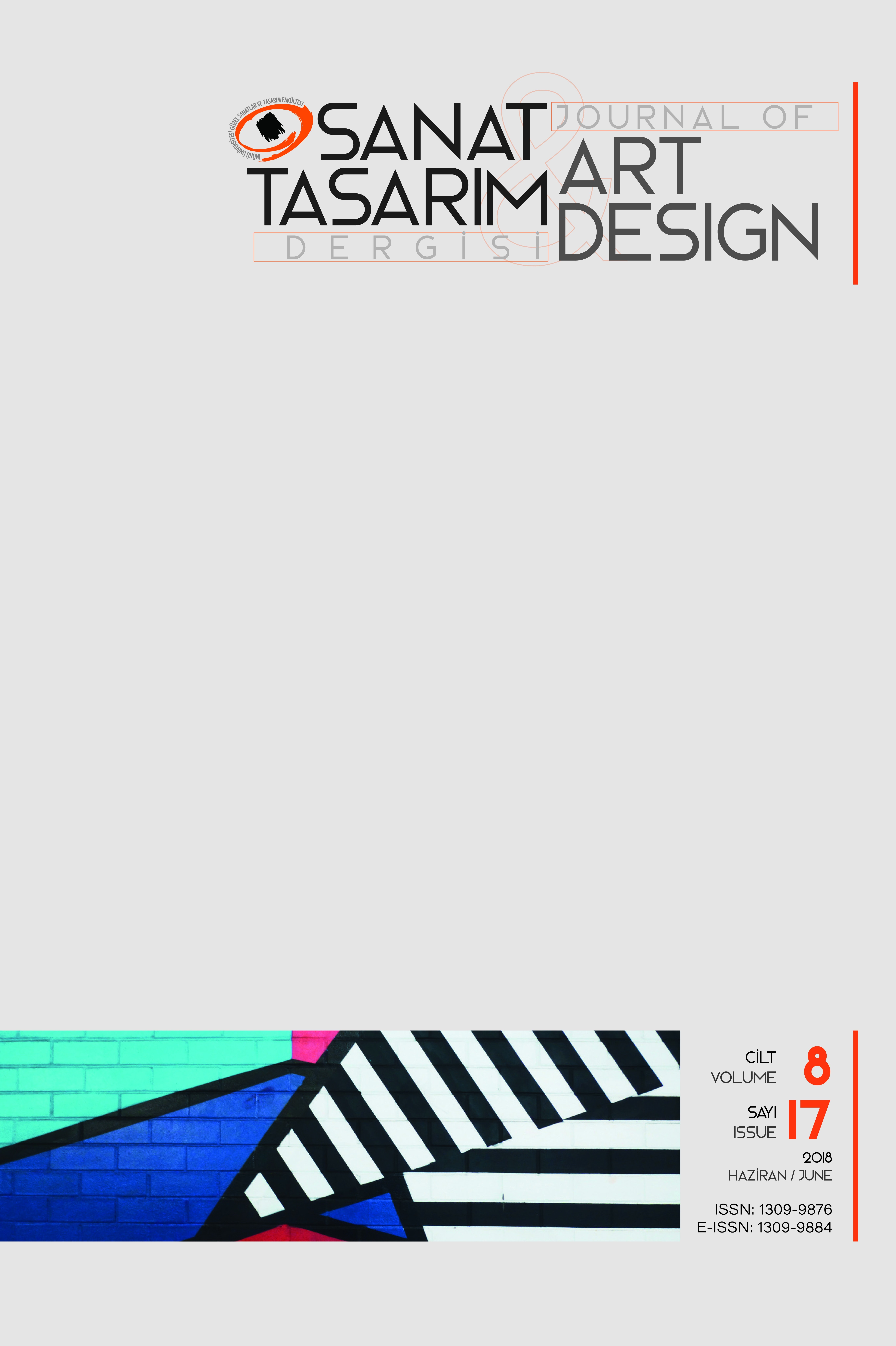Kent Ekolojisine Farklı Bir Yaklaşım: Tozlaşma Bahçeleri
Tozlaşma, Kent Ekolojisi, Biyoçeşitlilik, Pollination, Urban Ecology, Biodiversity
___
- Bağrıaçık, N. (2017). Polinatör Böcekler ve Küresel Tozlaşma Krizi (Pollinator Insects and Global Pollination Crisis), Iğdır Üniversitesi Fen Bilimleri Enstitüsü Dergisi, 7(4), 37-41.
- Buchmann, S. L., Nabhan, G. P. (1996). Forgotten Pollinators, Washington, D.C.: Island Press
- Cane, J. H., Griswold, T., Parker, F. D. (2007). Substrates and materials used for nesting by North American Osmia bees (Hymenoptera: Apiformes: Megachilidae), Annals of the Entomological Society of America, 100(3), 350- 358.
- Dyer, M. H. (2016). Plants For Pollinators: Learn About Pollinator Friendly Plants, 22 Mayıs 2018 tarihinde https://www.gardeningknowhow.com/garden-how-to/beneficial/pollinator-friendly-plants.htm adresinden erişildi.
- Ellsworth, D. (2014). Agrıculture And Natural Resources Fact Sheet: Attracting Pollinators to the Garden, Ohio State Unıversity Extension, Department of Entomology, 19 Şubat 2018 tarihinde https://u.osu.edu/beelab/files/2015/02/ENT_47_14_jan30-s4vma2.pdf adresinden erişildi.
- Evert, R. & Eichborn, S. E. (2015). Plant Growth and Reproduction (Part XI), Raven Biology of Plants, 8th Edition. 16 Ocak 2018 tarihinde http://www.mhhe.com/biosci/genbio/raven6b/graphics/raven06b/other/raven06_42.pdf adresinden erişildi.
- Free, J. B., Gennard, D., Stevenson, J. H., Williams, I. H. (1975). Beneficial Insects Present on a Motorway Verge, Biological Conservation, 8, 61-72.
- Garbuzov, M. & Ratnieks, F. L. W. (2014). Listmania: The Strengths and Weaknesses of Lists of Garden Plants to Help Pollinators, 64(11), 1019-1025.
- Güner, A., Aslan, S., Ekim, T., Vural, M., Babaç, M. T. (2012). Türkiye Bitkileri Listesi: Damarlı Bitkiler, İstanbul: Nezahat Gökyiğit Botanik Bahçesi Yayınları.
- Hegland, S. J., Nielsen, A., Lázaro, A., Bjerknes, A. L., Totland, Q. (2009). How Does Climate Warming Affect Plant‐Pollinator Interactions, Ecology Letters, 12(2), 184-195.
- Karadeniz, T. (2012). Meyve Yetiştiriciliğinde Polinasyonun Önemi, Verim ve Kaliteye Etkisi (The Importance of Pollination on Pomiculture and its Effects on Yield and Quality), 3. Uluslararası Muğla Arıcılık ve Çam Balı Kongresi Bildiriler Kitabı (s. 275-282.), Muğla.
- Korkmaz, A. (2016). Bitkilerde Bal Arısı Polinasyonu, Samsun: Samsun Gıda Tarım ve Hayvancılık İl Müdürlüğü Yayını.
- Klein, A. M., Vaissiere, B. E., Cane, J. H., Steffan-Dewenter, I., Cunningham, S. A., Kremen, C., Tscharntke, T. (2007). Importance of Pollinators in Changing Landscapes for World Crops, Proc. R. Soc. B. Biol. Sci., 274, 303–313.
- Krischik, V. & Tenczar, E. (2015). Pollinator Conservation, University of Minnesota, Center for Urban Ecology and Sustainability, 22 Şubat 2018 tarihinde https://www.extension.umn.edu/garden/plant-nursery-health/docs/2015-pollinator-conservation-bulletin-%20july.pdf adresinden erişildi.
- Mader, E., Shepherd, M., Vaughan, M., Black, S. H., LeBuhn, G. (2011). Attracting Native Pollinators: Protecting North America’s Bees and Butterflies, North Adams (MA): Storey Publishing, 371 p.
- Landis, T. D., Dumroese, R. K., Horning, M. E. (2014). Create a Pollinator Garden at Your Nursery: An Emphasis on Monarch Butterflies, USDA Forest Service, Rocky Mountain Research Station, Forest Nursery Notes, 34(1-2), 4-15.
- Özdemir, A. (2017). Kent Ekolojisine Farklı Bir Yaklaşım: Tozlaşma Bahçeleri. (Yayımlanmamış Lisans Tezi). İstanbul Üniversitesi Orman Fakültesi, İstanbul.
- Özhatay, N., Koçyiğit, M., Bona, M. (2010). İstanbul’un Ballı Bitkileri, İstanbul: Bal-Der Yayınları.Potts, S. G., Biesmeijer, J. C., Kremen, C., Neumann, P., Schweiger, O., Kunin, W. E. (2010). Global Pollinator Declines: Trendes, İmpacts and Drivers, Trends in Ecology and Evolution, 25(6), 345-353.
- Savard, J-P. L., Clergeau, P., Mennechez, G. (2000). Biodiversity Concepts and Urban Ecosystems, Landscape and Urban Planning, 48, 131-142.
- Sıralı, R., Cinbirtoğlu, Ş. (2018). Bal Arılarının Tozlaşmadaki ve Bitkisel Üretimdeki Önemi (The Importance of Honey Bees in the Pollination and Plant Production), Arıcılık Araştırma Dergisi, 10(1), 28-33.
- Sinnathamby, S., Assefa, Y., Granger, A., Tabor, L., Douglas, K. (2013). Pollinator Decline: US Agro-Socio-Economic Impacts and Responses, Nat Env Sci, 4(1), 1-13.
- Şahin, M., Topal, E., Özsoy, N., Altunoğlu, E. (2015). İklim Değişikliğinin Meyvecilik ve Arıcılık Üzerine Etkileri (The Effects of Climate Change on Fruit Growing and Beekeeping), Anadolu Doğa Bilimleri Dergisi, 6(Özel Sayı 2), 147-154.
- Tirado, R., Simon, G., Johnston, P. (2013). A Review of Factors that Put Pollinators and Agriculture in Europe at Risk, Greenpeace Research Laboratories Technical Report, 44 p.
- Url-1: Türkiye Bitkileri Veri Servisi, 12 Ocak 2017 tarihinde http://www.tubives.com/ adresinden erişildi.
- Url-2: Susan Reel, Attracting Pollinators to Your Garden Using Native Plants (Eastern United States), U.S. Forest Service, 12 Şubat 2018 tarihinde https://www.fs.fed.us/wildflowers/pollinators/documents/AttractingPollinatorsEasternUS_V1.pdf adresinden erişildi.
- Url-3: İstanbul’un Endemik Bitkileri, 21 Nisan 2017 tarihinde http://istanbulunendemikbitkileri.blogspot.com.tr/2012/03/istanbulun-endemik-bitkileri.html adresinden erişildi.
- Url-4: Türkiye Bitkileri, 9 Eylül 2017 tarihinde http://www.turkiyebitkileri.com adresinden erişildi.
- Url-5: The Plant List, 16 Şubat 2017 tarihinde www.theplantlist.org/ adresinden erişildi.Venturini, E. M., Drummond, F. A., Hoshide, A. K., Stack, L. B., Dibble, A. (2015). Enhancing Wild Bees Guidelines for Providing Native Bee Habitat on Farms, The Xerces Society for Invertebrate Conservation.
- Yılmaz, K. (2016). Bal Arılarının Bitkisel Üretimdeki Önemi, Ordu’da Tarım, 118, 1-2.
- ISSN: 1309-9876
- Başlangıç: 2011
- Yayıncı: İnönü Üniversitesi
Kent Ekolojisine Farklı Bir Yaklaşım: Tozlaşma Bahçeleri
MÜZİK VE RESİM İLİŞKİSİ: RESİM SANATINDA MÜZİĞİN YENİDENÜRETİMİNE İLİŞKİN ÖRNEKLER
KONUT MUTFAĞINDA KULLANICILARIN TERCİH ETTİĞİ MALZEMELER ÜZERİNE BİR ARAŞTIRMA; LEFKE ÖRNEĞİ
M. Selen ABBASOGLU ERMİYAGİL, Cemaliye SUNALP GÜRÇINAR
BİLİMSEL ÇALIŞMALARIN GELECEĞİN GİYİM TASARIMINA OLASI ETKİLERİ
Kilis Kentsel Sit Alanında Kullanıcı Odaklı Mekânsal Algı Belirlemeleri
Saliha TAŞÇIOĞLU, M.Faruk ALTUNKASA
KAMUSAL AÇIK ALANLARDA SANAT VE BATTALGAZİ ÇINAR PARK ÖRNEĞİ
Halil Fazıl Ercan, Halil Fazıl ERCAN
BİR KAVRAM VE BİR SANAT DALI OLARAK “SANATÇI KİTABI” ÜZERİNE BİR İNCELEME
20. YY. SONRASI SANAT PRATİĞİ İÇERİSİNDE SANATÇI DEFTERİNDEN SANATÇI KİTABINA BAKIŞ
PERFORMATIVE AESTHETIC AND ITS REFLECTION IN ANATOLIAN TRADITION
